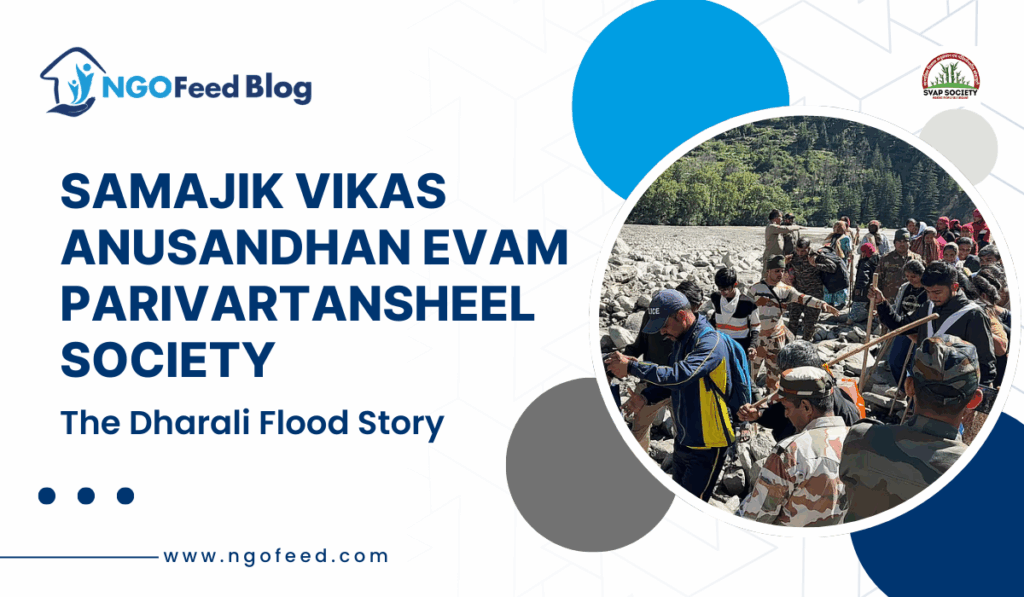Dharali Flood Samajik Vikas Anusandhan Evam Parivartansheel Society Story: In August 2025, the Himalayan state of Uttarakhand was once again jolted by nature’s fury. Torrential rains triggered flash floods across multiple districts, leaving behind a trail of destruction and despair. Among the worst-hit areas was the tranquil village of Dharali in Uttarkashi, a community known for its apple orchards, spiritual heritage, and resilient people. The disaster unfolded swiftly.
Table of Contents
Dharali Flood Story – Cloudburst Near Gangotri Valley
A sudden cloudburst near the Gangotri valley unleashed massive volumes of water, mud, and debris. Within minutes, rivers swelled beyond their banks, sweeping away homes, livestock, and vital infrastructure. Dharali, perched along a tributary of the Ganga, bore the brunt of this deluge. Families were forced to flee to higher ground as water surged through fields and homes, submerging crops and cutting off access to basic services. The national highway connecting Gangotri was severely damaged, with over 600 meters of road washed away near Dabrani.
Also Read: Role of NGOs in Environmental Protection
At Gangnani, a critical bridge collapsed, isolating villages upstream. The Border Roads Organization (BRO) responded swiftly, installing a temporary valley bridge, but full restoration remains weeks away. Meanwhile, landslides continue to pose threats to rescue operations and relief delivery. In Dharali, the floodwaters devastated apple orchards just weeks before harvest, dealing a severe blow to the local economy. Schools were shuttered, water sources contaminated, and electricity disrupted. Yet amid the disorder, the community rose to the challenge.
Samajik Vikas Anushandhan Evm Paritvartansheel Society – Team Efforts
Samajik Vikas Anushandhan Evm Paritvartansheel Society mobilized relief efforts, the team members coordinated with local authorities, and NDRF and SDRF began clearing debris and restoring pathways. Makeshift shelters were set up, and local kitchens prepared meals for displaced families. The flash floods also exposed critical gaps in preparedness. Early warning systems failed to reach remote hamlets in time. Many villagers reported receiving alerts only after the water had already entered their homes.
Also Read: Role of NGOs in Disaster Relief
Dharali Flood Story
The lack of resilient infrastructure, especially in ecologically sensitive zones, amplified the damage. Traditional water sources, many of which had been neglected, overflowed or collapsed, highlighting the urgent need to revive and reinforce these systems. This disaster is more than a natural calamity it is a wake-up call. Climate change is intensifying the frequency and severity of such events. The fragile Himalayan ecosystem, already under pressure from unplanned development and deforestation, cannot absorb these shocks without proactive intervention. Dharali Flood story underscores the need for community-led disaster preparedness, climate-resilient infrastructure, and policy support for sustainable resource management. But it is also a story of hope.
Dharali People Story
The people of Dharali have shown extraordinary resilience, unity, and courage. Their response—grounded in local knowledge, collective action, and unwavering spirit—offers a blueprint for recovery and long-term resilience. As relief efforts continue, there is an opportunity to rebuild not just infrastructure, but trust, systems, and safeguards that honor both tradition and innovation. Let Dharali’s story be heard—not just as a tale of loss, but as a call to action.
Also Read: Role of UNEP in the Environment
For every washed-out bridge, let there be a stronger one rebuilt. For every broken home, let there be a safer shelter. And for every community shaken by disaster, let there be a network of support, solidarity, and sustainable change.
Samajik Vikas Anushandhan Evm Paritvartansheel Society is regularly in touch with the affected people, coordinating with local authorities, and youth volunteers to providing relief for the affected families but its required more support to restore the life of affected people including their shelters and livelihood.



